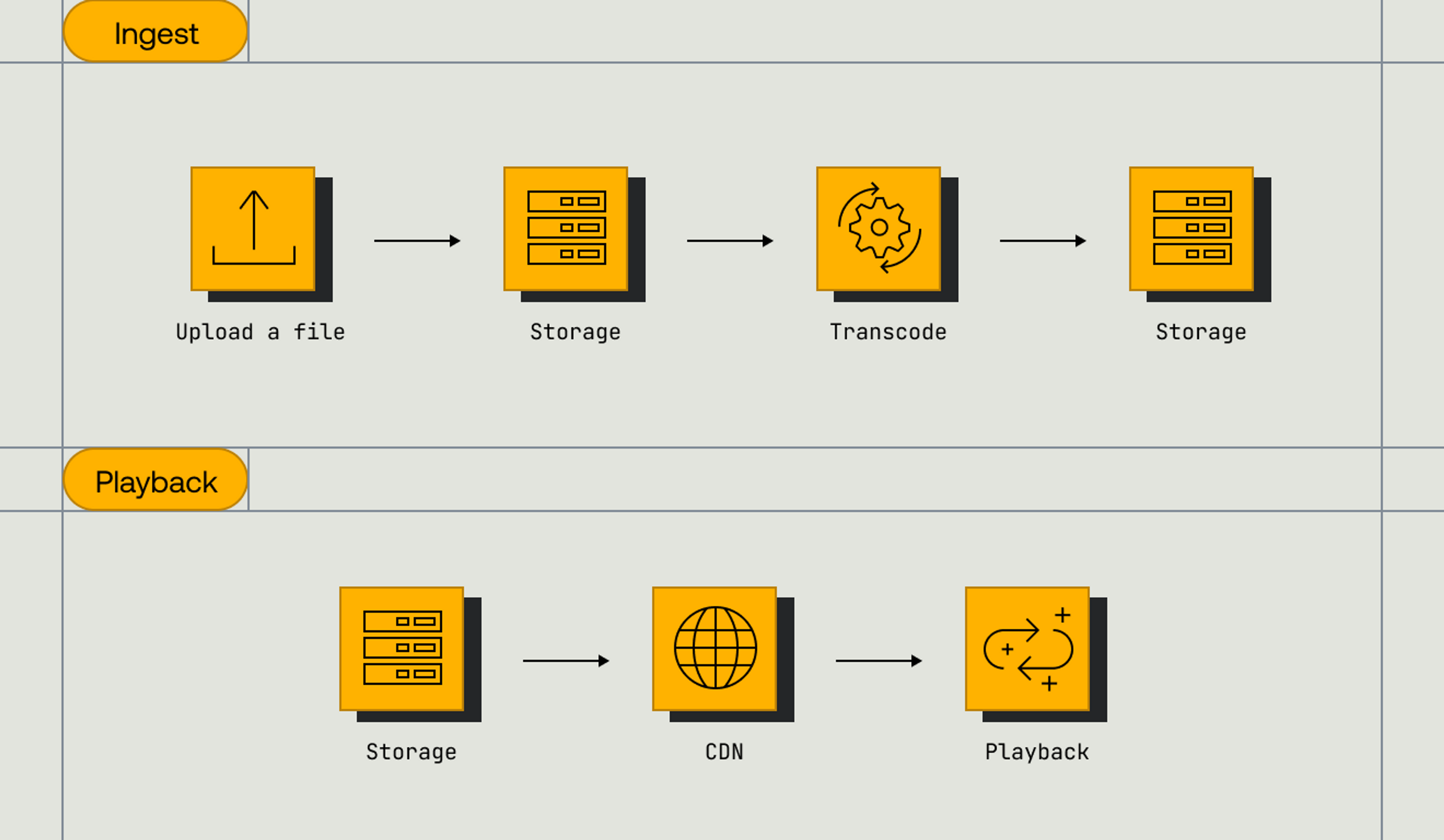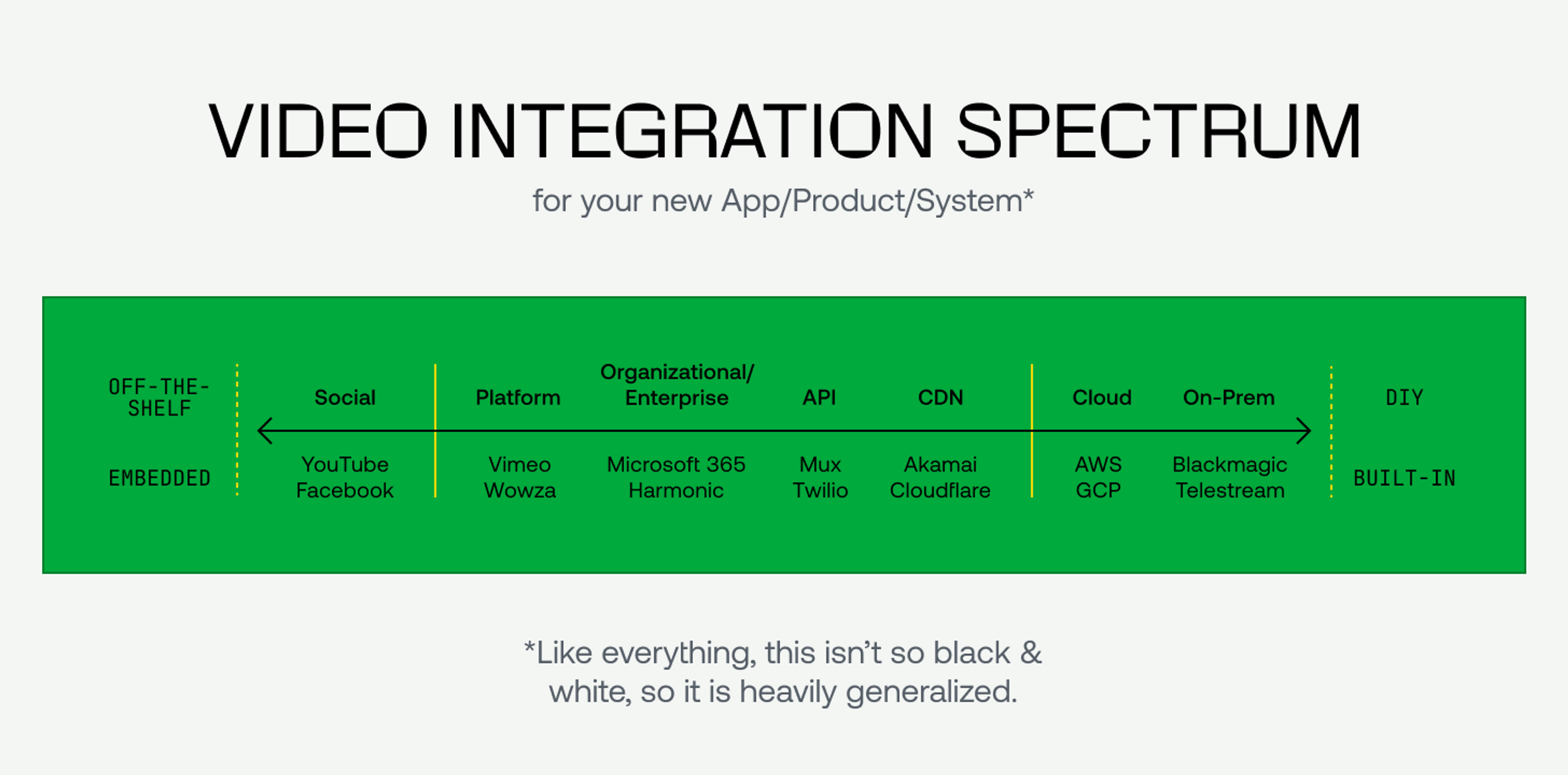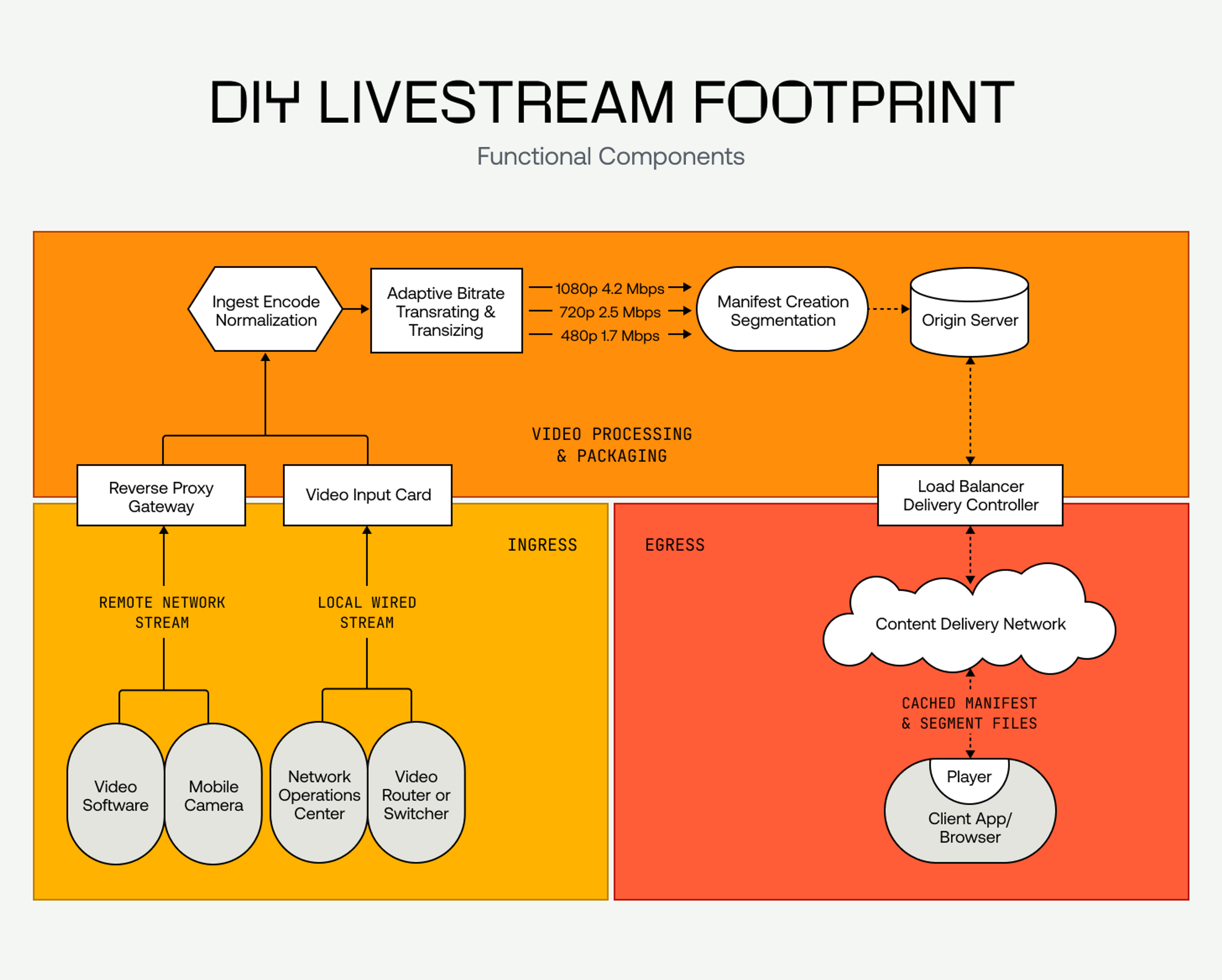“Video API” is a broad term that describes a category of APIs that do something related to video. Like any API, they provide access to a specific type of service which you can then build into an application.
If you're looking to start building straight away, Mux's Video API has everything you need to manage video for your application.
Different types of video APIs
Video APIs can include a wide variety of services. The following describes three categories specific to video technology:
- Video streaming API
- Video platform API
- Video player / Client-side APIs
1. Video streaming API
A video streaming API provides three core services:
- Encoding: Video compression so it’s viewable over the web.
- Storage: The API provider will usually store a copy or a master of your videos.
- Delivery: Video delivery is optimized through CDNs so your users get the best experience.
It essentially takes care of the backend technical decisions so you can focus on building the product. These APIs do not require you to use a specific player or CMS, giving you full control over both.
Example:

2. Video platform API
These APIs are all-inclusive services that, in addition to the core services above, include a player and required CMS and can provide most of what you may need to deliver video depending on your use case.
You’re probably already familiar with the social media video platforms. Social media examples:
Online Video Platforms (aka OVP) are targeted for B2B use. OVP examples:
- Brightcove
- Wistia
- JWPlatform (JWPlayer)
- Ooyala
- Kaltura
However, there are some tradeoffs for having a turnkey service and this is where a video streaming API could give you a simpler, more flexible solution.
Mux Video is the easiest and most cost effective api for video encoding, storage and delivery.
Learn more about Mux VideoVideo streaming APIs vs. OVPs
The key difference between a video streaming API and OVP is the abstraction layer in which they operate. An abstraction layer hides complexity of a system, and the higher the layer, the more it hides. OVPs operate at a varying levels of abstraction often offering very high levels of abstraction, such as a CMS, mixed with intricate technical details all combined into the same collection of APIs.
OVPs provide an out-the-box experience usually including bundled client-side SDKs, players, and a CMS. While this is powerful, it ties you closely to that provider’s data models and SDK integrations which can result in significant vendor lock in. With a video streaming API you’re free to use whatever CMS, player, or advertisement integrations you want - it gives you the power to structure, integrate, and brand your product in a way that makes sense to you.
A video streaming API contains a single, simple, highly abstracted API and used for the ingest and playback of your content. The intricate complexities of how your content is encoded, stored, and delivered is all taken care of by the services underlying API, allowing you to focus on building your product.
Video streaming APIs vs. YouTube
If you want to build your own Youtube (or Twitch or HQ), you wouldn’t be able to use YouTube (...or Twitch). You’d need the ability to support User Generated Content (UGC) – to have your users be able to upload video to your application plus stream to viewers. Of course, YouTube lets users directly upload content, but it doesn’t let developers build their own applications on the YouTube platform.
In addition, you’d probably want to build a custom experience for your unique audience and take into consideration the needs of both your users (content creators) and viewers (content consumers).
UGC examples:
To be able to create an application like those above, you’ll want to use a video platform with the following capabilities:
Control over UI and branding
If you’ve ever seen an embedded YouTube video, you can usually recognize it instantly–there’s the red “play” icon, set controls (Watch later, Share, Info, etc.) that are the same on every player, plus, dead giveaway, it says “YouTube” which takes you away from wherever you are and directs you back to their site. You may not want this as part of your product experience, especially if you’re creating an alternative or competitive product to any of the social media platforms.
Control over if and how your users see ads
YouTube already has ads built-in as a service so you have limited control over how the ad is displayed on your video and you can’t control when it’s shown. With a video streaming API, you can choose which ad insertion technology you want to use and create an ad experience that’s suitable for your business. But what if you want to monetize your content without ads at all? This leads us to the last point.
Generate revenue without the use of ads
Up until recently, the primary way to monetize your content on YouTube was through ads. They’ve since introduced other methods like creating paid subscriptions but it’s still relatively restrictive plus, you have to pay a fee. A video streaming API, however, gives you the freedom to explore a variety of business models and test pricing amounts to find the sweet spot for your product. You essentially get full control over productizing your video content.

3. Video player / Client-side APIs
Another type of video API you might run into are client-side video APIs. When you need to play back video in a browser or on a device, you’ll use these APIs to display video content to the user. Client-side video APIs operate at both high and low levels of abstraction depending on the control level you need over the playback experience. Most pre-packaged video players you could use will also have their own APIs–these players will leverage the lower-level video APIs on a device and provide you with a higher level of abstraction.
Here are some common client-side video APIs you might hear about on different platforms.
On Web Browsers:
- <Video> Element
- Media Source Extensions (MSE)
- Encrypted Media Extensions (EME)
Android:
- Exoplayer
- AVPlayer
iOS:
- AVFoundation
When Would a Video API Be Necessary?
Video APIs help make building video-driven applications much more simple. Instead of worrying about maintaining a complex video transcoding pipeline, you can limit your exposure to additional infrastructure and development costs and instead leverage a service to process and deliver your video content.
3 Benefits of Using Video APIs
Enhanced productivity
When you offload the complexity of a video transcoding and delivery pipeline to a third party API, you no longer need to be a video expert or have a team of video engineers on hand to manage the infrastructure you’ve built. Instead, you can spend your cycles focusing on what makes your business unique, and lean on the expertise of a video API platform to handle the challenging aspects of online video delivery.
Quicker time-to-market
Video APIs can be significantly quicker to implement into your application than building your own solution. By using a video API like Mux, you can get professional video features into your application within days, without having to know how it all works behind the scenes. This allows your engineers to stay productive building application features that bring additional functionality and business value to your company.
Reduced development costs
Quicker development times means lowered engineering costs for your business. By using a video API, you can avoid staffing a team of video developers and you can apply your engineering cycles to other areas of your business instead. Video APIs also leverage metered billing. This allows you to only pay for what you use rather than paying to cover the running costs for your own always-on video encoding servers.
Future Trends in Video API Technology
Video is constantly changing. New approaches, formats, and technologies are evolving at all times, so video APIs must always be introducing new features to meet the trends of a fast-paced industry. Here are just a few examples of emerging trends within video API infrastructure.
Increased Use of AI in Video APIs
As AI becomes more common in our everyday lives, you will start to see AI applications in the video API landscape as well. One clear example for how AI can be applied to video APIs is through the use of auto-generated captions on your videos. Video APIs may start to create automatic captions for your video content to help make it more accessible for your audience. AI plays a critical role in deciphering your video content and generating the text that ultimately appears as captions for your video.
Focus on User Privacy and Data Security
Data protection and user privacy is of utmost importance, so it’s natural to see improvements in how video APIs may introduce improvements to the storage, handling, and retrieval of user data with programmatic access. If security is a critical factor for your business, it’s important to determine how a video API company implements and communicates their security policy. Here at Mux, we provide a safe and secure environment for our customers and their viewers. We currently hold an ISO 27001 certificate. This covers both digital and physical security aspects for both the Mux Data and Mux Video products.
Improvements in Live Streaming Video APIs
Video APIs will always need to keep up with the newest formats, codecs, and capabilities. As such, you can expect live streaming video APIs to evolve and accommodate this demand. This can take a lot of pressure off of you; no longer do you have to stay on top of the ever-changing and complicated video tech field.
A good video API will adapt to the latest evolutions and keep you up to date automatically. One example of a newer improvement to the live video streaming space is Secure Reliable Transport (SRT) which reduces latency and improves upon stream quality compared to older technologies.

Video APIs play a major role in the digital landscape
There’s no doubt that video APIs are here to stay. By using video APIs, you can realize many improvements that reduce complexity and introduce efficiencies in your business.
If you’re looking for more advice on how to incorporate video APIs into your company’s products or services, we’re here to help. Reach out to our team or book a call — we can work together to make this journey as easy as possible for you.